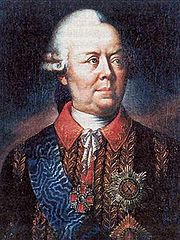(1725-1796)
Military commander, from 1774 known as Rumiantsev-Zadunaisky for his military victories “across the Danube.”
Peter Alexandrovich Rumyantsev was the son of Alexander Ivanovich Rumyantsev, who rose to prominence in the circle of Peter I, and Maria Andreyevna Matveyeva, whose father was an ambassador and senator. Early in the reign of Empress Anna (1730-1740), the Rumyantsevs fell from favor, but Alexander resumed service in 1735 and was rewarded with the hereditary title of count. In 1748 Peter Rumyantsev married Princess Ekaterina Mikhailovna Golitsyna, with whom he had three sons, Mikhail, Nikolai, and Sergei. He was estranged from his wife early in the marriage.
Despite earning a reputation for dissolute behavior, young Peter Rumyantsev received several commissions in the army. He served with distinction in the Seven Years’ War (1756-1762), commanding a cavalry regiment during several successful Russian actions. Having been promoted by Emperor Peter III, he expected to be exiled when Catherine II (r. 1762-1796) seized power, but in 1764 she made him governor-general of Ukraine, with the task of integrating that territory into the Russian administrative and fiscal system. He carried out a major survey and census, introduced a new postal system and courts, and revised laws on peasants. In 1767 he was summoned to participate in the Legislative Commission and was required to investigate Ukrainian delegates to minimize claims for independent privileges and institutions for the region.
At the outbreak of the Russo-Turkish war in 1768, Rumyantsev was first given command of Russia’s Second Army and charged with the responsibility of guarding the southern borders. He then took over the First Army from Prince Alexander Mikhailovich Golitsyn. He won victories in July 1770 at Larga and Kagul against great odds and went on to capture towns in Ottoman-held Moldavia and Wallachia. In 1771 he moved west to the Danube, and in 1773 he laid siege to towns in the region but was forced to retreat by supply difficulties. In 1774 Rumyantsev’s forces outmaneuvered the Turkish vizier and forced him to accept peace terms at Kuchuk Kainardji.
Rumyantsev was made a field marshal and received the orders of St. George and St. Andrew, as well as lavish rewards that included landed estates. He returned to Ukraine to implement Catherine’s Provincial Reform (1775). In the second Russo- Turkish War (1787-1792) Rumyantsev commanded the Ukrainian army, but was in the shadow of Grigory Potemkin. His last major campaign was in Poland in 1794 against Tadeusz Kosciusko. When he died, Emperor Paul ordered three days mourning in the army in his honor.
BIBLIOGRAPHY Alexander, John T. (1983). “Rumiantsev, Petr Aleksandrovich.” In Modern Encyclopedia of Russian and Soviet History, edited by Joseph L. Wieczynski, vol. 31, 15-19. Gulf Breeze, FL: Academic International Press.
